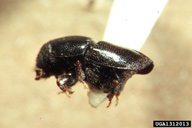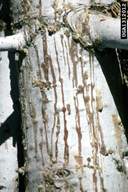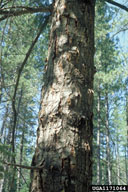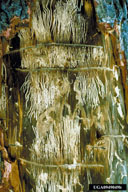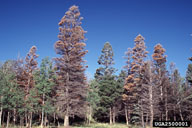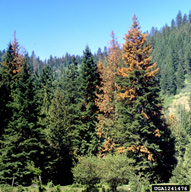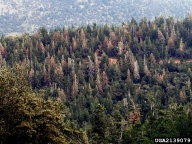Fir engraver
Scolytus ventralis LeConte (Coleoptera: Curculionidae, Scolytinae)
Orientation to pest
The fir engraver, Scolytus ventralis LeConte, is a pest of true firs in western North America. Adults are about 4.0 mm long, making this one of the largest species in the genus Scolytus. The egg galleries dug by females are transverse to the trunk and galleries are deep enough to deeply score the wood, especially close to the nuptial chamber. Eggs are laid along the oviposition galleries, from which larvae dig lateral galleries up or down the trunk after hatching. Pupation occurs in the inner bark at the end of the larval galleries. Fir engraver attacks trees of varying ages and transmits the brown-stain fungus Trichosporium symbioticum Wright, which is essential for successful brood development. Stressed trees that are infected with various fungi or that have been damaged by outbreaks of other insects are likely to be attacked by the fir engraver. Effects of this bark beetle vary, with some trees dying quickly, while others are just top-killed or recover, even from repeated attacks. There is one generation per year, or in some areas, only one in two years. In intensively managed areas, prompt removal or treatment of infested trees may help protect remaining trees for a time, but in most areas control is best achieved by trying to lower sources of stress and maintain high tree vigor.
Hosts commonly attacked
The principal hosts of the fir engraver are various species of fir (Abies), especially white (Abies concolor [Gordon] Lindley ex Hildebrand), grand (Abies grandis [Douglas ex D. Don] Lindley), and red fir (Abies magnifica A. Murray). Occasionally Douglas-fir (Pseudotsuga menziesii [Mirbel] Franco), hemlock (Tsuga), or spruce (Picea) are attacked.
Distribution
The fir engraver ranges from British Columbia to California, Wyoming, Colorado, Arizona, and New Mexico.
Images of Fir engraver
| Figure 1. Adult of the fir engraver, Scolytus ventralis | Figure 2. Pitch streamers on trunk are a sign of attack on fir by the fir engraver | Figure 3. Bubbled bark is a sign of previous fir engraver attacks survived by a tree | Figure 4. Galleries of the fir engraver. Note the horizontal oviposition gallery, with multiple larval galleries above and below |
| Figure 5. White fir (Abies concolor) killed by the fir engraver | Figure 6. Top kill is a sign of attack of fir engraver on large, otherwise healthy, trees | Figure 7. Damage at the stand level from the fir engraver |
Important biological control agents related to this pest species
The natural enemies of fir engraver are relatively unstudied.
Web links for information on Fir engraver
Articles
- Berryman, A. A. 1973. Population dynamics of the fir engraver, Scolytus ventralis (Coleoptera: Scolytidae). I. Analysis of population behavior and survival from 1964 to 1971. The Canadian Entomologist 105: 1465-1488.
